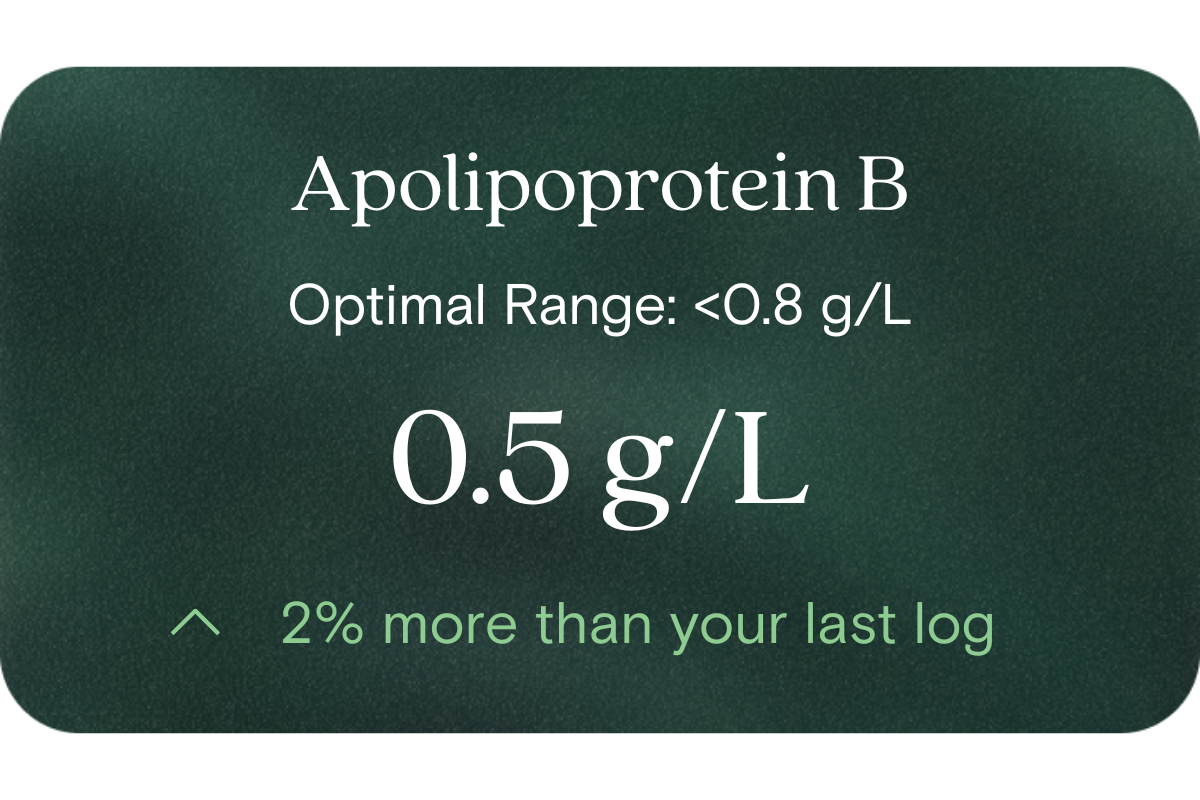What is Apolipoprotein B?
ApoB is a protein that integrates into all the atherogenic lipoprotein particles (LDL, VLDL, IDL, Lp(a)). Because each of these particles carries exactly one ApoB molecule, the concentration of ApoB in the blood serves as a direct count of how many of those particles are present.
Why does it matter for long-term health and wellbeing?
Each ApoB particle has the potential to penetrate arterial walls and contribute to plaque accumulation. That means that even if cholesterol mass looks normal, a high particle count (high ApoB) can indicate greater load on vascular health. In contrast, lower ApoB suggests fewer pro-atherogenic particles, which supports healthier circulation, metabolic balance, and longevity. The stronger predictive power of ApoB over LDL-cholesterol is increasingly supported by epidemiological and mechanistic research.
What’s an optimal level of ApoB?
- Optimal range (for proactive performance & prevention): less than 0.8 g/L
- Laboratory / reference (population) range: low 0.48 g/L to high < 1.3 g/L
- In practice, values below ~0.9 g/L are often considered favourable, whereas levels above ~1.1 g/L raise a flag for elevated particle burden.
What influences ApoB levels?
Several lifestyle and metabolic factors can raise or lower ApoB:
- Dietary pattern (especially saturated fats, refined carbs, excess calories)
- Body fat distribution, especially excess visceral fat
- Insulin sensitivity, glucose regulation and metabolic health
- Lipid turnover and liver lipid handling
- Genetics (variation in lipoprotein processing)
- Physical activity, weight loss, and dietary composition
What does it mean if ApoB is outside the optimal range?
- Above optimal range (e.g. > 0.8 g/L): suggests a higher number of circulating atherogenic particles. Even if standard cholesterol tests are “normal,” this may point to an elevated particle burden that could accelerate vascular wear over time.
- Below the reference floor (e.g. < 0.48 g/L): may hint at malabsorption, very low lipid synthesis, or rare genetic variations, and should prompt a broader evaluation of nutritional balance and fat metabolism.
How can I support healthier ApoB levels?
- Adopt a diet rich in whole, minimally processed foods—emphasising monounsaturated fats (olive oil, avocado, nuts), omega-3 sources, plenty of fibre and low glycaemic carbohydrate patterns
- Achieve and maintain healthy body composition, particularly reducing visceral fat
- Improve insulin sensitivity via regular physical activity and resistance training
- Monitor carbohydrate quality and avoid excess refined sugars
- Support liver health (e.g. moderate alcohol, maintain good sleep, antioxidant variety)
- Track progress over time with repeat testing and small adjustments
This information is provided for general health and wellness purposes only and does not replace medical advice.
References
- Glavinovic, T., Thanassoulis, G., de Graaf, J., Couture, P., Hegele, R. A., & Sniderman, A. D. (2022). Physiological bases for the superiority of apolipoprotein B over low-density lipoprotein cholesterol and non–high-density lipoprotein cholesterol as a marker of cardiovascular risk. Journal of the American Heart Association.
- De Oliveira-Gomes, D., et al. (2024). Apolipoprotein B: Bridging the Gap Between Evidence and Clinical Practice. Circulation.
- MSAC (Australia). 1512 – Apolipoprotein B testing for high risk cardiovascular.
- Fujino, M., et al. (2025). Achieved levels of apolipoprotein B and plaque stability.




















.png)
